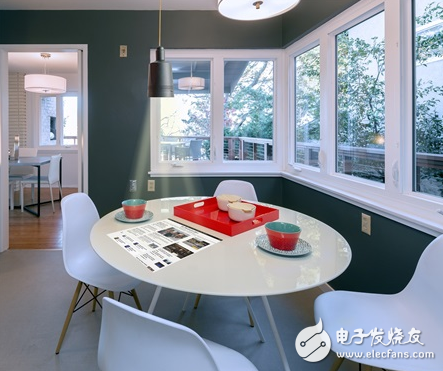When most people plan to use projection technology at home, the picture that comes to mind is often a high-tech home theater. Now, the rapid development of smart homes and the Internet of Things (IoT) provides users with a new way to view projection displays.
Smart homes and IoTs bring greater connectivity and greater intelligence to many everyday devices – from air conditioning and residential security systems to cooktops and refrigerators. The next generation of these smart residential devices has the potential to integrate projection display technology to enhance the human-machine interface in intelligent systems.

Projection display for smart homes
The embeddable, durable and energy-efficient projection technology provides a powerful and efficient way to display information for smart home devices and enables users to interact with devices through a simple touch and gesture interface.
For example, instead of going to the dryer to look at the rest of the time as before, now you just need to wave your hand at the projection display in the kitchen to know when the clothes will be washed.
You can adjust your thermostat, set up your sprinkler system, check the inventory in the fridge, look up the menu, warm up the microwave, and see who is outside the gate – all of this information is in the same display Provide and support some quick finger taps, or gesture recognition.
In fact, the form of projection display is varied. Projects can be projected onto a single screen using an existing home theater solution. The display may also be embedded in a lighting fixture and projected onto a wall or kitchen worktop. It could also be a small projector that protrudes out of the wall when it is used, and when it is not in use, it is retracted and hidden to maintain aesthetics.
Smart home shows which devices are needed
For designers, there are a few things to keep in mind when developing smart home displays. When designing any kind of display technology, image quality may be one of the most important considerations for many possible environmental factors in home furnishings such as multi-faceted surfaces. The high contrast and color gamut of TI DLP® PicoTM technology enables vivid, detailed images with high fill rates for smooth and delicate images.
Developers should also consider the user's need for flexible and scalable projection solutions that can be displayed on different surface sizes over a short distance with good resolution. This requirement must be achieved in conjunction with a compact and compact light engine that can be integrated into household appliances without negatively impacting existing size and appearance.
Light efficiency is another important area in high-brightness designs that pursue low power consumption and low heat.
At Texas Instruments, we offer a broad portfolio of DLP Pico display chipsets and evaluation modules; they come in different sizes and resolutions to help you get started quickly. Our DLP Pico technology, based on a set of highly reflective aluminum micromirrors called Digital Micromirror Devices (DMDs), provides several introductions for developers who want to include projection displays in their smart residential device designs. Eye-catching features. We also recommend that you visit our TI E2ETM Community DLP Products and MEMS Forum to ask questions and share knowledge and develop thinking with peer engineers and TI experts.
Smart home technology has had a huge impact. However, adding interactive displays to hybrid devices will fundamentally change our way of life in the future. We can't wait to see how application developers can tap the unlimited potential of projection displays to make smart homes truly intelligent.
Want to start designing work right away? In this white paper for smart home applications, you can read more about how Pico projection technology can truly replace buttons, tablets, LCD panels and mechanical knobs in every room.
ETOP WIREHARNESS LIMITED , https://www.etopwireharness.com
